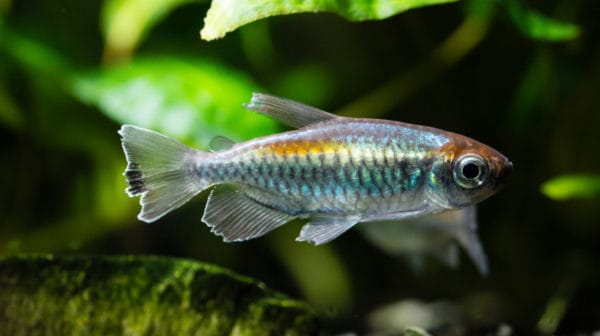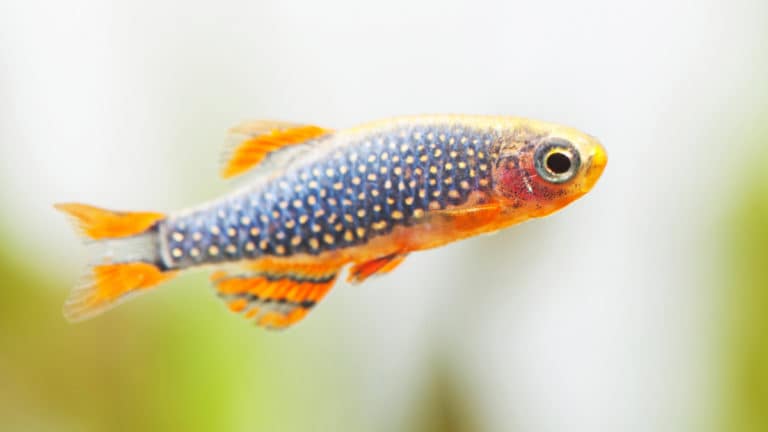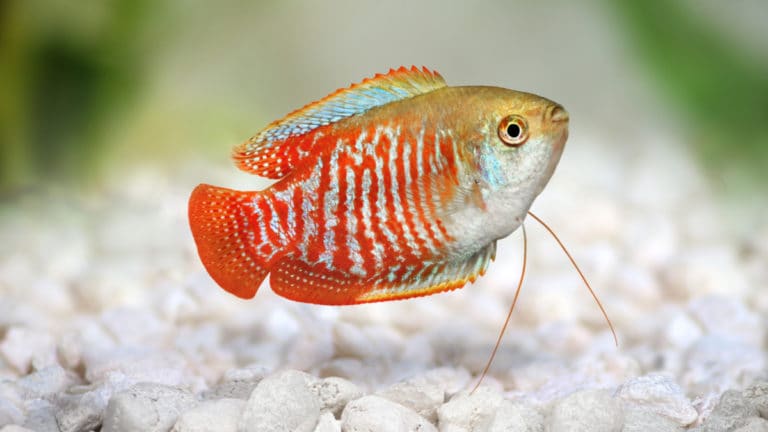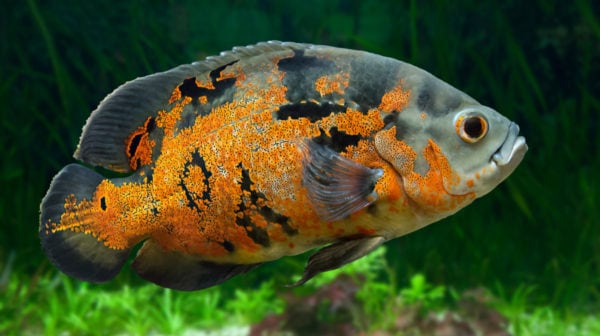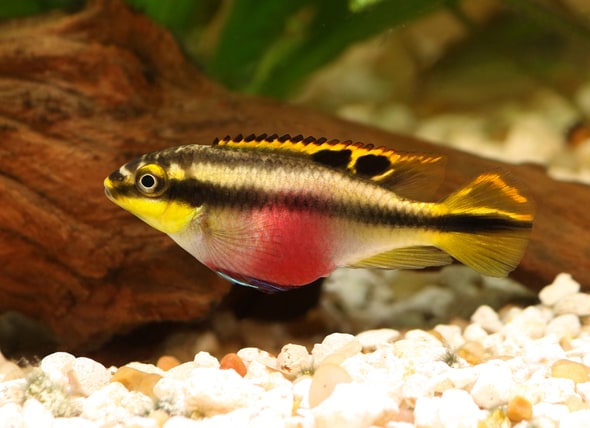Recognition of success in the organized aquarium hobby of today puts considerable emphasis on the ability to breed one’s fishes. Most hobbyists start their efforts at breeding and raising fish with the livebearing species (such as guppies, mollies or platies) and then “progress” to egglaying species, perhaps by purchasing a tank full of Malawi mbuna. (There really is not much difference from the breeder’s standpoint because in both cases the hobbyist simply feeds the fish and collects the babies as they are seen.)
Real progress comes in the next step, in which the hobbyist switches to either the substrate-spawning cichlids or to killifish. But something seems to cause the modern aquarist to stagnate at this point. There seems to be very little enthusiasm for going further or trying “new” types of fishes.
In my earlier days (not really prehistoric times), the step after the livebearers was to some “simple” egg-layer such as the white cloud mountain minnow or a danio or even a barb (all members of the minnow family or Cyprinidae). After success at this plateau, we felt we could scale the heights and try to breed tetras!
Reminiscing about those early days of my fish aquarium hobby, I recall just how impressed I was when I heard that someone had bred a species of South American tetra. The idea still bears some of the same connotations, but now I know the truth.
Breeding tetra fish is not so much a nearly impossible task that can only be accomplished by someone of vast skill and determination as it is a sign of someone who is willing to pay attention to detail and to give nature a chance to take its course. Although I have not spawned all of the known tetras (far from it), I have had the good fortune to have had more than 40 species spawn in my tanks, and I have been able to raise to maturity most of the fry resulting from almost all of these species. I have also had my share of failures. From this experience, I have learned that there are ten simple things to keep in mind which will allow almost anyone to succeed with most tetras. I’ll share these with you in the hope that you will be less likely to put up with the occasional failures I had to.
There are two groups of five steps each in my system. The first five steps are part of the advance preparation to spawning a species.
1. Buy Young Breeding Stock
Young stock has had less chance of being contaminated by disease or of having been harmed by poor water conditions or water quality. Young stock also has the added useful quality of being less expensive. The dealer’s tanks containing these fish are not labeled “breeding stock” or “jumbo,” and therefore do not command that extra high price.
2. Buy Several Fish At Once
I buy at least a dozen of any prospective breeder, but the number generally exceeds 25 for any species I am particularly interested in breeding. Most pet shops will give a discount for quantity purchases (again lowering the initial investment). But the real reasons for buying several fish are that you have a safety margin in case you lose a fish or two while raising them to maturity, and you have a choice of fish from which to choose for your breeding stock once the actual breeding is to take place.
3. Maintain Good Aquarium Conditions
This sounds too obvious to include here, but it is too important to ignore. Remember that the quality of the breeding stock has a direct bearing on the viability of the spawn, and the quality of the breeding stock is a direct result of the conditions under which it has matured. Most tetras that we encounter in the hobby originate in soft, acidic waters with no traces of ammonia, nitrite or nitrate. The closer we can match these conditions, the better the breeding stock will be.
4. Feed A Variety Of Foods
The more varied the diet, the greater the number of vitamins and amino acids available to the fish as they grow and mature into adults. The nutritional needs of fish are often greatly undervalued by many aquarists. While the manufacturers of prepared foods generally provide excellent products, their claims that these foods supply everything a fish needs should be accepted with caution. It is better to be safe, providing additional types of foods, than it is to give less than is needed. Live foods should be an integral part of the diet of any potential breeding fish. The vitamins, minerals and trace elements in live foods can make all the difference is a breeding program. In addition, the “challenge of the hunt” seems to give an extra sparkle to fish that is missing with fish that receive only prepared, freeze-dried or frozen food. Of course, this may just be the “romantic” in me talking!
5. Choose Pairs Carefully
The important factor of this step is the word pairs. They should be adults (although recently matured fish may give limited success), but they must be a pair (a male and a female). Many times, after trying to determine why a fellow hobbyist was unsuccessful in attempting to breed a species of tetra, I found that the hobbyist did not know how to tell a male from a female and was working with two fish of the same sex. A little research is sometimes necessary to learn how to tell the difference for some species. Let me give you a few generalizations that may help.
Mature females are usually a little larger than the males. They are also a little more plump around the belly area. Females generally have shorter dorsal and anal fins and lack ray extensions on any of the fins. Colors are slightly less vivid.
Mature males are generally a little smaller in length and slightly more slender than females of the same age. Males frequently have elongated fins or extended rays on the fins. Colors on the fins and body are noticeably more brilliant.
When looked for in individual fish, these differences can sometimes be difficult to see, but when a large group of similarly aged fish that have been raised together is inspected, the differences are often startling. Some fish make it much simpler for the aquarist by exhibiting major differences that are discernible with only casual examination.
The emperor tetra, Nematobrycon palmeri, can be sexed at about two weeks of age! If a flashlight, held slightly to the side of the aquarist’s head, is shined on the fry, the eyes of the females will reflect a pale green coloration and the males will reflect a sparkling blue color. Black phantom tetras, Megalamphodus megalopterus, on the other hand, must be approaching maturity before their distinguishing characteristic appears, but it is just as obvious. The adipose fin, that fleshy little lump behind the dorsal fin that seems to be there only to make people ask questions, is a different color in each sex — the female’s is red while the male has a black adipose fin. There are other species with equally recognizable differences, but I’ll let you find them yourself.
There is one other good method of distinguishing a pair of tetras — let them tell you. If you have a small school of the same species of tetra, and two of them always swim together, slightly apart from the others, it’s a safe bet that they are a pair. They should be your first choice as prospective breeders because they are already demonstrating a special compatibility for each other. Half of the battle is won when you have this situation.
The next five steps relate to the process of spawning the fish and raising the fry. Thus, step six is to condition the breeders. Once the prospective parents are determined, they can, in theory, immediately be placed in a breeding setup. It is far better, however, to isolate the fish from each other and all other members of their species. While in their own tanks, each member of the pair is given an especially rich and nutritious variety of foods to ensure that the female’s ovaries are stimulated and filled with eggs and the male is full of milt with which to fertilize them. This final conditioning usually takes about two to three weeks and allows sufficient time to make any other preparations that are deemed necessary.
7. Set Up The Spawning Tank
Up to this point, we have been trying to give the fish as much swimming and living space as possible. Now, however, it is better to think about using a small tank — 2 to 5 gallons in capacity — because it is easier to control aquarium conditions during the limited time of the spawning period. I normally use a 5-gallon, all-glass aquarium because it is small enough to easily lift but big enough for the largest South American tetras to spawn in. The tank must be thoroughly cleaned to ensure that there are no stray particles of organic material to decompose and foul the water. I use hot water and a scrub brush, but no chemicals.
The water that is used in the spawning tank may well be the most important part of a successful spawning. Adults tetras are quite flexible about the conditions in which they live. The eggs and fry do not allow the aquarist the same leeway. Start with the softest water possible. My tap water, which can vary from 35 to 75 ppm (parts per million) carbonate hardness, works fairly well at its lower point, but proves unsatisfactory in the upper range. If my water is too hard to start with, I will dilute it with distilled water. Many aquarists use a water softener, which I feel is unsatisfactory because of the high sodium ion concentration that results. An alternative method, “reverse osmosis,” is an excellent way to obtain soft water.
Once water with sufficient softness is located, I run a fish tank filter filled with pre-boiled peat moss to make the water slightly more acidic and to lessen the hardness even further. I do this in the largest tank that I have at my disposal, because I can always find good uses for extra water. After filling the breeding tank, some water is used in the conditioning tanks to acclimate the breeders to the spawning tank water chemistry. The remainder is reserved for water changes after the fry are hatched. I find that the best water chemistry is a hardness of under 30 ppm carbonate hardness and a pH between 6.0 and 6.5.
There may be short period of delay at this point. I find that it is important for me to be able to spend the morning with the intended “bride and groom.” The day before the spawning, I re-clean the spawning tank, put in a raised plastic grate (cut to exactly fit the bottom of the tank) that prevents the parents from getting to and eating any eggs that may fall to the bottom, fill the tank with conditioned water, heat the water to 78 degrees Fahrenheit and add a suitable spawning site. (The normal site is a clump of fine-leaved plant, such as Myriophyllum, which I have frequently used with good success, but more commonly I use an artificial spawning mop made of synthetic knitting yarn because it is easier to clean and will not break down or decompose in the spawning tank.) I then cover the tank and wait until evening.
8. Spawn The Adults
The pre-conditioned breeders are added to the spawning tank in the evening, the female first and the male at least a half hour later. The tank is covered to prevent jumping and then a cardboard box is put over the entire tank to keep out all light (this is done so that I can control the morning light of the next day to fit my needs). The normal spawning in the wild takes place at “first light.” The same holds true in the aquarium. My cardboard box has a special cutout of approximately one-third of the front panel that can be removed easily to allow limited visibility and “first light” at any time of the day.
In the morning, when I am ready to spend a little time with the fish, I remove the cutout and allow daylight to reach the fish. If the light intensity is low, the breeders will generally start their courting dance within 15 minutes. If the light is too bright, it may take as much as an hour before anything seems to happen. The actual spawning differs from species to species (which is what makes the whole process so interesting), but generally starts with the male doing a dance around the female.
Once she accepts his overtures and follows him to the actual spawning site, there is a side-by-side trembling that results in a small number of eggs being laid and fertilized. A rolling or tumbling motion scatters the fertilized eggs over the selected spawning site. In some cases, the eggs are placed in selected locations. This sequence is repeated several times until all of the eggs are laid and fertilized (the number of eggs can vary from less than 50 from some species to more than 1000 in other species).
Up to this point, the aquarist has only watched the fish do what comes naturally. The next step in the natural process is for the tired breeders to replenish some of the energy that was expended during the spawning. They do this by eating anything that they can find that is small and organic, like maybe eggs! Nature prevents excessive egg-eating by allowing natural water movements or currents to drift the exhausted parents away from the eggs, but the confines of the home aquarium keep the fish within eating distance of the eggs. The aquarist can eliminate this problem by returning the breeders to their conditioning tank and feeding them. If hungry breeders are left with their own eggs, it is not unusual for them to eat each and every egg produced during the spawning. The only ones that are missed are those that fall into the plastic grate on the tank bottom or are hidden in the spawning site.
After removing the parents, change at least 50 percent of the water with some of the extra water prepared for the breeding tank. This is done to remove any waste products deposited by the breeders or any extra milt produced by the male in the spawning attempts that might decompose and harm the eggs. After the water change, place the cardboard box back over the tank for at least 36 hours. To varying degrees, all tetra eggs are sensitive to light — too much light can destroy an entire spawn.
After the 36-hour period, remove the panel in the cardboard and check for fry. They will look like very tiny splinters of glass that spiral around the tank or stick to the side. If they are not seen, replace the panel for another 12 hours and then check again. If no fry are seen after three inspections, carefully remove the cover and check the condition of the eggs. Do not use a bright light! If the eggs are covered with fungus or are milky-white, they are infertile or dead and you will have to start again. If the eggs are black or if you can see an embryo inside, put the cardboard cover back on the tank and continue your periodic inspections until the eggs hatch.
9. Feed The Fry
The eggs and resulting fry of tetra spawnings are quite small. Any fish food that is given to the fry must be small enough to be eaten by them. The food must be in sufficient quantity to feed all of the fry, yet not so much that it can decompose and foul the water. Prepared commercial foods provide the necessary nutrition needed by the fry but can be very difficult to use in proper quantities.
Small live foods, frequently referred to as “infusoria,” are easy to culture and come in a variety of types and sizes that will provided a varied diet. In addition, excess food will remain alive for later feedings, whereas prepared foods will decompose, polluting the water. The use of infusoria, however, must be planned for in advance of the actual spawning to ensure that the food is available when it is needed. Infusoria is used only for a relatively short period of time, three days to three weeks, depending on the growth rate of the species. When the fry are large enough to eat other foods, they should be weaned over to the new foods gradually rather than simply stopping one type and starting the next.
The two best foods at this stage are newly hatched brine shrimp nauplii and “microworms.” The brine shrimp nauplii are readily obtained in the form of packaged eggs available in most local fish stores or by ordering direct from suppliers. The eggs are easily hatched by following the directions supplied with the eggs. Do not add the hatching solution (salt water) to the fry tank — siphon the nauplii into a very fine net and rinse with freshwater before using as food for baby tetras. The microworms, tiny nematodes that are scientifically known as Anguilula silusiae, are not as easy to find. Starter cultures are frequently available from mail-order suppliers of live foods, but it is better to try to find another hobbyist who has some and can show you how to properly maintain this food supply. If you belong to an aquarium society, some of the members, particularly those who are active and older, can often provide a starter culture andvaluable information on maintaining it. When the fry outgrow these foods, they can be considered young adults and fed the same foods as the breeding stock.
10. Maintain Proper Water Quality For The Fry
This may seem like a repetition of step three, but there is a difference here. Although the problem is the same, the magnitude is much greater because of the increased number of fish. You should change water as frequently as possible, carefully siphoning the bottom of any accumulated debris. A sponge filter can be very effective in this setup. Move the fry to a larger aquarium as soon as they are able to eat newly hatched brine shrimp and microworms.
Carefully maintain the water temperature in the larger tank to prevent chills and the frequently accompanying disease, ich (white spot), while slowly weaning the fry from the breeder tank water to your normal aquarium water. Plan on splitting the spawn into smaller, more manageable groups as they grow. Two 20-gallon aquariums are generally enough for raising most tetras to a saleable size, but some species require several more. As you can see, none of the ten points are difficult to accomplish. They are simply common sense aquarium techniques that, when combined, can add a new and enjoyable facet to your aquarium hobby. Then you too will be ranked among the “elite” of the aquarium hobby.
Posted by: Chewy Editorial
Featured Image: Lapis2380/Shutterstock
Share:
